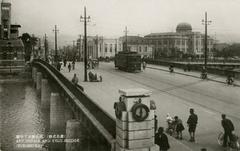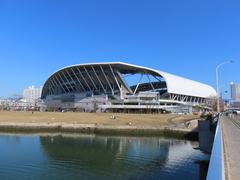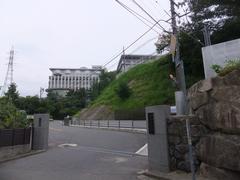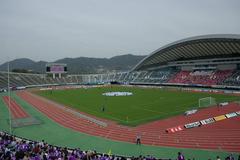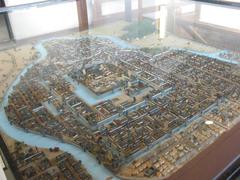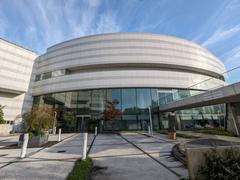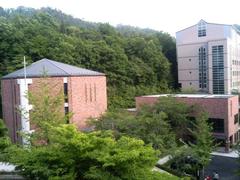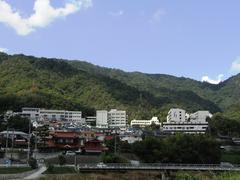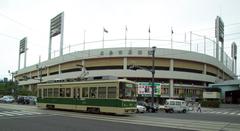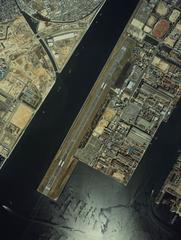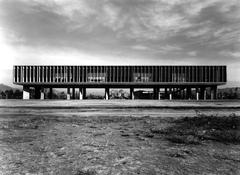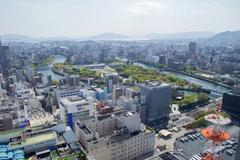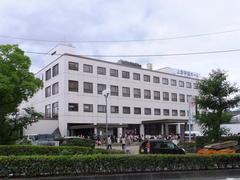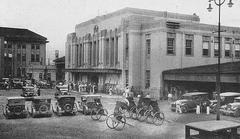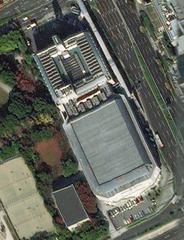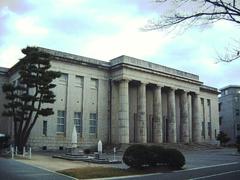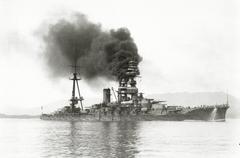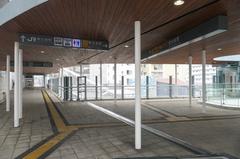Nishi-Hiroshima Station Visiting Hours, Tickets, and Travel Guide
Date: 15/06/2025
Introduction: The Significance of Nishi-Hiroshima Station
Nishi-Hiroshima Station (西広島駅, Nishi-Hiroshima-eki) is more than a vital transit hub in Hiroshima, Japan—it is a living symbol of the city’s resilience, historical transformation, and cultural vitality. Connecting JR West’s Sanyo Main Line and the Hiroshima Electric Railway (Hiroden) tram network, the station stands at the heart of the Koi-cho district in Nishi-ku. Its story spans from its origins as Koi Station in the late 19th century through its pivotal role during World War II and the city’s post-bombing recovery, to its current status as a modern, accessible gateway for both commuters and visitors.
Strategically positioned, the station offers easy access to major landmarks such as Hiroshima Peace Memorial Park, Miyajima Island’s Itsukushima Shrine, and the Shimanami Kaido cycling route. With integrated train, tram, and bus networks, flexible ticketing options like IC cards (ICOCA, PASPY), and guided tours, Nishi-Hiroshima Station is the ideal starting point for exploring Hiroshima’s historical and cultural treasures.
Experience Hiroshima’s enduring spirit at Nishi-Hiroshima Station—where every journey connects the present with the city’s compelling past. (Mayors for Peace; Wikipedia; Japan Experience)
Contents
- Introduction
- Historical Evolution and Role in Hiroshima’s Rail Network
- Wartime Experience and Post-Bombing Recovery
- Survivor Trams: Living History
- Modernization and Urban Development
- Visiting Hours and Ticketing Information
- Station Layout, Facilities, and Accessibility
- Nearby Attractions and Cultural Points of Interest
- Travel Tips for Visitors
- Guided Tours and Visual Resources
- Frequently Asked Questions (FAQ)
- Plan Your Visit
- Conclusion
- Sources
Historical Evolution and Role in Hiroshima’s Rail Network
Nishi-Hiroshima Station opened in 1897 as Koi Station (己斐駅), part of the San’yō Railway’s expansion to meet Hiroshima’s industrial and residential needs. The railway was nationalized in 1906 and became the San’yō Main Line in 1909. Renamed Nishi-Hiroshima Station in 1969, it evolved into a crucial interchange after the privatization of Japan National Railway (JNR) in 1987, coming under JR West management. The station’s redevelopment culminated in a new building opening in December 2022, prioritizing accessibility and modern amenities (Wikipedia).
Wartime Experience and Post-Bombing Recovery
During World War II, with many male workers conscripted, teenage girls operated the trams, demonstrating community resilience. On August 6, 1945, the atomic bombing devastated Hiroshima and the tram network. Remarkably, tram service between Koi (now Nishi-Hiroshima) and Nishi-Tenmacho resumed just three days later, staffed by an all-female crew. This act became a powerful symbol of hope and the determination to rebuild (Mayors for Peace).
Survivor Trams: Living History
Some streetcars, known as “survivor trams” or “hibaku densha,” withstood the atomic bombing and continue to operate today. Notable examples include Car No. 653 and Car No. 654, which serve as moving memorials, allowing passengers to connect viscerally with Hiroshima’s past (Mayors for Peace).
Modernization and Urban Development
The station’s latest redevelopment, completed in 2022, introduced barrier-free design, expanded platforms, modern waiting areas, and improved signage. These upgrades reflect Hiroshima’s commitment to accessibility and passenger comfort, while the surrounding district flourishes with shops, restaurants, and literary monuments such as the statue of “The Zukkoke Trio” (Dive Hiroshima).
Visiting Hours and Ticketing Information
Operating Hours:
- Station open: Daily ~5:00 AM to midnight
- Ticket counters: ~6:00 AM to 10:00 PM
- Automated ticket machines: 24/7
Tram and Train Services:
- JR Sanyo Main Line and Hiroden trams typically run from 5:00 AM to midnight (check official timetables for line-specific details).
Ticketing:
- JR train tickets: Automated machines and staffed counters
- Hiroden tram tickets: At tram stops or on board
- IC cards accepted: ICOCA, PASPY, Suica, PASMO, and others
- Visit Hiroshima Tourist Pass: Unlimited rides on JR trains and Hiroden trams (Japan Experience)
Luggage Services:
- Coin lockers and luggage delivery services available
Station Layout, Facilities, and Accessibility
JR Section:
- Platforms: One ground-level side platform and one island platform (four tracks)
- Facilities: Elevators, escalators, tactile paving, multilingual signage, climate-controlled waiting rooms
Hiroden Tram Section:
- Two side platforms for Main Line and Miyajima Line trams
- Seamless transfer between JR and Hiroden
- Ramps and pedestrian crossings for accessibility
Additional Amenities:
- Restrooms (including accessible and baby-changing facilities)
- Free Wi-Fi, charging stations
- Retail: Convenience stores, cafés, vending machines
- Security: CCTV, emergency intercoms, on-site staff
Nearby Attractions and Cultural Points of Interest
- Hiroshima Peace Memorial Park: Commemorating atomic bomb victims, with museums and monuments (Trip to Japan).
- Miyajima Island: Home to Itsukushima Shrine, accessible via Hiroden Miyajima Line and ferry.
- Peace Boulevard: A scenic avenue symbolizing Hiroshima’s post-war recovery.
- Hondori Shopping Street: Vibrant arcade for shopping and local cuisine.
- Hiroshima Nishi Fire Station: Notable for its architecture (ArchDaily).
- Shimanami Kaido: Start point for a renowned 70-kilometer cycling route.
Travel Tips for Visitors
- Use IC Cards: For seamless, cashless travel on trains, trams, and buses.
- Plan Connections: Allow extra time for transfers during peak hours.
- Accessibility: The station is fully barrier-free, but check elevator and restroom locations as needed.
- Guided Tours: Join local tours focusing on Hiroshima’s historical sites and survivor trams.
- Luggage: Utilize lockers or delivery services for hands-free sightseeing.
Guided Tours and Visual Resources
- Walking Tours: Many begin at or near Nishi-Hiroshima Station, exploring survivor trams and memorial sites.
- Photo Opportunities: Capture historic streetcars, modern station architecture, and panoramic city views.
- Virtual Tours and Maps: Available via JR West and Hiroshima tourism portals.
- Descriptive Visual Media: “Historic survivor tram at Nishi-Hiroshima Station” enriches visitor engagement.
Frequently Asked Questions (FAQ)
Q: What are the station’s operating hours?
A: Generally from 5:00 AM to midnight; ticket counters from 6:00 AM to 10:00 PM.
Q: Where can I buy tickets?
A: Automated machines and staffed counters (JR); tram tickets at stops or on board.
Q: Are IC cards accepted?
A: Yes, including ICOCA, Suica, PASMO, and more.
Q: Is the station accessible?
A: Fully accessible with elevators, escalators, tactile paving, and accessible restrooms.
Q: How do I reach Miyajima Island?
A: Take the Hiroden Miyajima Line tram from the adjacent stop to Miyajima-guchi, then a ferry.
Q: Are there luggage storage options?
A: Yes, coin lockers and luggage delivery are available.
Plan Your Visit
For real-time transit updates, route planning, and trip suggestions, download the Audiala mobile app. Consult official resources for current schedules and ticketing:
Check local tourism sites and social media for event updates, special tram runs, and travel inspiration.
Conclusion
Nishi-Hiroshima Station is not just a stop on your journey—it is a gateway to Hiroshima’s living history, cultural richness, and enduring resilience. Its blend of modern convenience, deep historical roots, and proximity to world-renowned sites ensures every traveler can experience the spirit of Hiroshima. Start your exploration here, supported by accessible facilities, informative guides, and seamless connections to the best of the region.
Sources and Further Reading
- Mayors for Peace – Girl Power: How Hiroshima’s Young Women Kept the Trams Running
- Wikipedia – Nishi-Hiroshima Station
- Japan Experience – Hiroshima Trams
- Trip to Japan – Complete Guide to Hiroshima History, Culture, and Modern Charm
- Dive Hiroshima – Zukkoke Trio Monument
- ArchDaily – Hiroshima Nishi Fire Station
